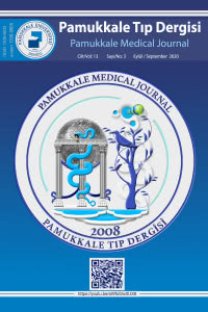Serebral Palsi tanısı ile izlediğimiz çocuklarda kullandığımız ortezler ve fonksiyonel durum ile ilişkisi
Serebral Palsi, ortez kullanımı
___
- KAYNAKLAR1. Çağlıyan Türk A, Özel S. Serebral Palsi Tanısı ile İzlediğimiz Hastaların Demografik ve Klinik Özellikleri. Journal of Physical Medicine Rehabilitation Sciences 2018;21:71-77. 2. Danino B, Erel S, Kfir M, Khamis S, Batt R, Hemo Y, et al. Influence of orthosis on the foot progression angle in children with spastic cerebral palsy. Gait Posture 2015; 42:518-522. 3. Balaban B, Yasar E, Dal U, Yazicioglu K, Mohur H, Kalyon TA. The effect of hinged ankle-foot orthosis on gait and energy expenditure in spastic hemiplegiccerebral palsy. Disabil Rehabil. 2007;29:139-144.4. Sankar C, Mundkur N. Cerebral palsy-definition, classification, etiology and early diagnosis. Indian J Pediatr 2005;72:865–868.5. Aboutorabi A, Arazpour M, Ahmadi Bani M, Saeedi H, Head JS. Efficacy of ankle foot orthoses types on walking in children with cerebral palsy: A systematic review. Ann Phys Rehabil Med 2017;60:393-402.6. Tıkız C. Ortezler. In: Hepgüler SA, Gökben S, ed. Serebral Palsi. İstanbul: Nobel Tıp Kitabevleri, 2017;147-1697. Ofluoğlu D. Orthotic management in cerebral palsy. Acta Orthop Traumatol Turc 2009;43:165-172.8. Dilek B, Gözde G, Yakut Y. Serebral palsili çocuklarda ayak-ayak bileği ortezi kullanım süresini etkileyen faktörlerin incelenmesi: pilot çalışma. Journal of Exercise Therapy and Rehabilitation 2015;2:47-52.9. Morris C. Orthotic management of cerebral palsy. Dev Med Child Neurol 2007;49:791-796.10. Hagberg B, Hagberg G, Olow I. The Changing Panaroma of Cerebralpalsy in Sweden. I. Prevelance and Origin during the Birth Year Period 1983-1986. Acta Paediatrica 1993;82:387-393.11. Palisano R, Rosenbaum P, Walter S, Russell D, Wood E, Galuppi B. Development and reliability of a system to classify gross motor function in children with cerebral palsy. Dev Med Child Neurol 1997;39:214-223.12. Scrutton D, Damiano DL, Mayston M. Management of the motor disorders of children with cerebral palsy. 2nd edition. Cambridge: Cambridge University Press, 2004;9-146. 13. Blair E, Watson L. Epidemiology of cerebral palsy. Semin Fetal Neonatal Med 2006;11:117-125.14. Öneş K, Çelik B, Çağlar N, Gültekin Ö, Yılmaz E, Çetinkaya B. Serebral palsi polikliniğine müracaat eden hastaların demografik ve klinik özellikleri. Türk Fiz Tıp Rehab Derg 2008;54:13-16.15. Özel S, Çulha C, Delialioğlu SÜ, Sarı İF, Köklü K. The relationship between the Gross Motor Function Classification System and treatment modalities in children with cerebral palsy. Turk J Phys Med Rehab 2016;62:116-122.16. Sanger TD, Delgado MR, Gaebler-Spira D, Hallett M, Mink JW; Task Force on Childhood Motor Disorders. Classification and definition of disorders causing hypertonia in childhood. Pediatrics 2003;111:89-97.17. Öztürk B, Uygur F, Yakut Y. Effect of ankle-foot orthoses on functional performance and physiological cost index in children with cerebral palsy. Journal of Exercise Therapy and Rehabilitation 2015;2:86-9218. Houltram J, Noble I, Boyd RN, Corry I, Flett P, Graham HK. Botulinum toxin type A in the management of equinus in children with cerebral palsy: an evidencebased economic evaluation. Eur J Neurol 2001;8:194–202.19. Chen W, Liu X, Pu F, Yang Y, Wang L, Liu H, et al. Conservative treatment for equinus deformity in children with cerebral palsy using an adjustable splint-assisted ankle-foot orthosis. Medicine (Baltimore) 2017;96:e8186.20. White H, Jenkins J, Neace WP, Tylkowski C, Walker J. Clinically prescribed orthoses demonstrate an increase in velocity of gait in children with cerebral palsy: a retrospective study. Dev Med Child Neurol 2002;44: 227-232.21. Radtka SA, Skinner SR, Johanson ME. A comparison of gait with solid and hinged ankle-foot orthoses in children with spastic diplegic cerebral palsy. Gait Posture 2005;21:303-310.
- ISSN: 1309-9833
- Yayın Aralığı: 4
- Başlangıç: 2008
- Yayıncı: Prof.Dr.Eylem Değirmenci
Uzun Süre Litotomi Pozisyonunda Kalmaya Bağlı Gelişen Peroneal Palsi
Enjekte edilebilir kalsiyum fosfat çimentosu ile tedavi edilen el enkondromları
Ali ÇAĞDAŞ, Ahmet Fahir DEMİRKAN, Alp AKMAN, Ali KİTİŞ, Hande USTA
Atrofi ve proksimal kas güçsüzlüğü olan olgu: seronegatif Lambert Eaton Myastenik Sendrom
Bahar SAY, Ufuk ERGÜN, Gülten KARACA
İsmet PARLAK, Bahadır ÇAĞLAR, Saylav BORA, Alper Fehmi GÜNDÜZ
Normal gözlerde yaş ve cinsiyetin retina kalınlığına etkisi
İnguinal herni hastalarında açık mı kapalı teknik mi daha fazla stres yaratır?
İrfan COŞKUN, Feridun Suat GÖKÇE
Normal gözlerde yaş ve cinsiyetin retina kalınlığına etkisi’
